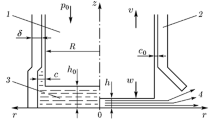Abstract
The nature of fracture under impulsive loading is examined. It is shown as a consequence to Drucker's stability hypothesis that, under impulsive loading, it is strain rate and not total strain that plays the dominant role in determining fracture criteria. Rinehart and Pearson's criteria for rupture of cylindrical shells, which are consistent with the above, are extended to spherical shells. Experimental program on polystyreneplastic shells of different sizes is reported. Dominant fracture pattern observed was brittle. Also, critical velocity of straining (V cr) was found to be directly proportional to the cube of the diameter of the shell. On the basis of dimensional considerations, it is shown that the shell-wall thickness has no effect upon the number of fragments. The effect of material properties on fracture is also examined.
Similar content being viewed by others
Abbreviations
- σ ij (1), σ ij (2) :
-
stresses
- ∈ ij :
-
strains
- \(\dot \sigma _{ij} \) :
-
stress rate
- \(\dot \varepsilon _{ij} \) :
-
strain rate
- ρ:
-
density of the material
- λ:
-
N/V
- D :
-
shell diameter
- E :
-
Young's modulus
- N :
-
number of fragments
- t, t a, tb, τ:
-
time
- V cr :
-
critical velocity of straining
- V :
-
particle velocity
- h :
-
wall thickness
References
Drucker, D. C., “A Definition of Stable Inelastic Material,”Jnl. Appl. Mech.,26,101–106 (1959).
Griffith, A. A., “The Phenomena of Rupture and Flow in Solids,”Trans. Royal Soc. (London), A,221,163–198 (1921).
Orowan, E., “Fundamentals of Brittle Behavior in Metals,” Contribution to Conf. on Fatigue and Fracture of Metals at M.I.T. (1950).
Irwin, G., “Fracture Dynamics,” Fracting of Metals, ASM, 147–166 (1948).
Mott, N. F., “Fragmentation of Shell Cases,”Proc. Royal Soc. (London), A,189,300–308 (1946).
Rinehart, J. S., and Pearson, J., “Behavior of Metals under Impulsive Loading,” ASM, 123–145 (1954).
Kolsky, M., “Fractures Produced by Stress Waves,”Fracture (Proc. Conf. on Fracture at M.I.T.), John Wiley and Sons, New York, 281–296 (1959).
Taylor, G. I., “The Formation of a Blast Wave by a Very Intense Explosion,”Proc. Royal Soc. (London), A,201,159–174 (1950).
Author information
Authors and Affiliations
Rights and permissions
About this article
Cite this article
Garg, S.K., Siekmann, J. On fracture of a thin spherical shell under blast loading. Experimental Mechanics 6, 39–44 (1966). https://doi.org/10.1007/BF02327112
Issue Date:
DOI: https://doi.org/10.1007/BF02327112




